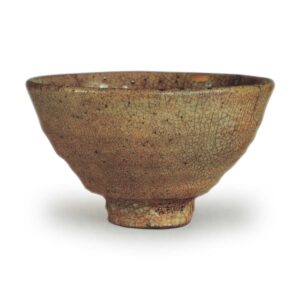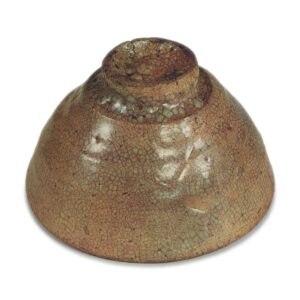

Name: Koen-ido
Daimyo-butsu
Height: 8.9-9.4cm
Diameter: 14.4-14.7cm
Height of foot ring: 5.2-5.5cm
Height of body: 1.5cm
It is said that this name comes from the fact that it was given to a certain Mr. Sakabe of Kyoto Ginza by Toyotomi Hideyoshi. Later, it came into the possession of Toki Iyomori, who renamed it “Koen”, but in the early Meiji period, it became the property of the Sakai family and was restored to its original name. The origin of the name “Koen” is not known. In the “Famous Tea Bowl Collection”, it is written, “The Sakabe Ido tea bowl was originally owned by Sakabe Sanjuro and is a famous and high-quality tea bowl. The Toki family called it Kōen, but while it was in our possession, it was called Sakabe Ido as before.
In terms of the size of the diameter and height of the famous tea bowls and daimyo tea bowls, this Sakanabe is slightly smaller in diameter, but excels in terms of the depth of its interior. The curve of the bowl from the rim to the foot is extremely fine, with five distinct levels, and the small but tight foot supports the asymmetrical bowl shape, giving it a dynamic appearance that is not just quiet, but could even be called rich.
The glaze is a so-called loquat color, but the fact that it shows a glaze that has been applied both inside and out is probably the most distinctive feature of this tea bowl. On the outside of the rim, there is a white glaze that flows in a pattern resembling the skin of a Japanese plum, and on the body, there are several spots of white glaze scattered in a dripping pattern from the center to the waist. Also, there is a diagonal glaze chip from the middle of the wheel marks to the foot ring, which is also a highlight of this piece. The foot ring is strongly cut around the foot ring, forming a pattern resembling the skin of a Japanese plum, but there is some clay showing. The bamboo nodes and small foot ring tatami mat are polished to show the clay, but inside there is a beautiful plum skin pattern, and the hood stands gently. The inside is deep, but the tea pool in particular is impressive for its depth. There are no eye marks. There is one crack running from the rim to the body, and there are also a few small cracks and a few places where the rim has been repaired.
Inner box: paulownia wood, plain finish, paper pasted to the lid: “Ko-en” by Toki Iyomori Junsetsu, same as above, note on the reverse of the lid: “Ko-en Ido Tochika no Jukki Eien Kazo-sha Yazu, Tei-yu, February 18th, Rai-in (signature seal),” there are four accompanying letters, and if we combine this with what is recorded in “Fushimiya Fuki” , and other records, it is known that it was sold to Fukae Shōzaemon of Kyoto’s Ginza district for 597 ryō in the time of Sakabe Sanjuro, a descendant of Sakabe, but due to the loss of the original owner, it was passed to the Mitsui family, and then to Toki Iyomori, the Osaka Castle Governor. It was valued at 850 ryou. In the early Meiji period, when it was acquired by the Toki family, the feudal lord of Wakasa Obama, and Sakai Tadanori, the Kyoto governor, it was valued at 1,500 ryou, together with the Yodoyabune flower vase that was also given to him. Later, in 1923, it was transferred to its current owner at a Sakai family household goods auction.
The Taisho Meiki Kan (A Guide to Famous Tea Bowls of the Taisho Period) includes a picture of what appears to be a Tsushima tea bowl in the section on the Sakaibeido tea bowl, but it is unclear why such an error occurred. Incidentally, the tea bowl listed in the Sakai family auction catalog of 1923 is the one shown here.



